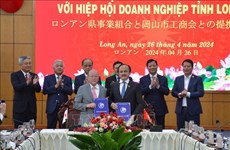Positive signs seen in footwear export
With 80 percent of workers returning to work in factories and abundant orders right from the beginning of the year, the footwear sector has seen bright prospects for this year.
 Illustrative image (Source: VNA)
Illustrative image (Source: VNA)According to the General Statistics Office (GSO), in the first month of 2022, domestic firms exported 390.3 million worth of handbags and umbrellas and over 1.93 billion USD worth of footwear products.
Phan Thi Thanh Xuan, Vice Chairwoman of the Vietnam Leather and Footwear Association (Lefaso), said that local firms have received enough orders for the whole second quarter of 2022, which is a good condition for them to speed up production and regain growth pace after a long period of stagnation caused by COVID-19.
Right from the beginning of the year, many giant brands such as Nike and Adidas have shown their interest to increase their output in Vietnam.
According to the Lefaso representative, Vietnam has become the biggest production hub for Nike by producing 50 percent of its products. Production and export of Nike account for about 30 percent of the export revenue of the whole sector, and create jobs for about 300,000 labourers. It has also revealed its plan to expand operations in Vietnam.
Xuan held that the other reason making Vietnam attractive to big players in footwear and sportswear industry is the good system of factories and competitive labour cost. Moreover, consumers in the US tend to like “made-in-Vietnam” products, she added.
However, experts held that it is not easy to grasp chances to boost Vietnamese footwear exports in 2022 due to a high cost of material and logistics services. Meanwhile, Government’s support packages have yet to show effectiveness, while orders from large brands often have high quality standards.
In order to ease difficulties facing businesses during the recovery process, Xuan said the Government, ministries and sectors should promptly implement the 350 trillion VND (15.38 billion USD) support package for economic recovery and development and make it easier for businesses to access.
At the same time, it is necessary to review and adjust policies that hinder production and export activities such as exchange rate and tax, while issuing new policies to support businesses to make full use of free trade agreements to increase exports, she said, stressing the need to improve the quality of human resources.
Xuan also underlined the need to continue improving logistics infrastructure system, designing better strategies for material development, attracting more investment to industrial parks, and researching new product designs and materials./.













